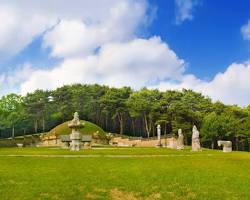I have included the special meaning discovered at Hwaseong-si's Yunggeonneung, the geomancy interpretation of Gonsinji, in WordPress.
Let's go beyond a simple visit and feel the deep wisdom contained in Joseon royal tombs.
Yunggeonneung, where King Jeongjo's filial piety is embedded, and Gonsinji is at the center of it
Yunggeonneung is the name of the Yungneung of King Yeongjo, the 21st king of Joseon, and his son, King Jeongjo, and his son, King Hyo-ui, and his son, King Jeongjo, the 22nd king.
Situated under Mt. Suwon, it was also called 'Hwasanneung', and it is said that King Jeongjo often visited Yungneung out of filial piety.
Yunggeonneung, which was registered as a UNESCO World Heritage Site in 2009, has not only historical value but also an interesting geomancy point.
1. In search of the secret of Gonshinji, geomancy
Yungneung has an artificial pond, Gonshinji (坤申池), built according to the principles of geomancy.
As someone who has always been interested in geomancy, I was curious about how Gonshinji was built.
Although it was possible to approach Jeongjagak below Yungneung, the area around the tomb was blocked by iron fences, making it difficult to determine the exact direction.
Usually, you need to place a patch on the tomb or the soul stone and measure it to determine the exact direction.
2. The direction of Gonshinji inferred from Jeongjagak and management office data
I inferred the direction of Gonshinji based on what I examined at Jeongjagak and the data I obtained from the management office.
When Yungneung is viewed as Gyejajeonghyang (癸坐丁向), the direction of Gonshinji is Jeongmipa (丁未破).
However, Jeongjagak points to Jeongmihyang (丁未向), and it does not seem to be in an exact straight line with the tomb.
This is a common feature that appears in other royal tombs.
3. The meaning of Gonsinji as interpreted by the 88-hyang method
If we analyze it again using the 88-hyang method, the bureau of Yungneung is judged to be Mokguk (木局).
The exact location of the wave (波) was difficult to confirm, but it seems that Gonsinji was created because there should be a wave in Gonsinji under the premise of a jjaesaejeonghyang.
In this case, the wave becomes the left-turning water (左旋水).
If the direction of the tomb could only be set by the direction of the account, then in the 88-direction method, if the water (pond) is placed in the direction of the Son-sa-hyang (巽巳向), it becomes the direction of the right yang (正陽向), if it is placed in the direction of the Im-ja-hyang (壬子向), it becomes the direction of the declining fetus (衰向胎流), and if it is placed in the direction of the Gon-sin-hyang (坤申向), it becomes the direction of the right mausoleum (正卯向).
#Yunggeonneung #Gon-sin-ji #Pungsu-jiri #Joseon Royal Tombs #Hwaseong #Jeongjo #Pungsu-jiri #88-direction method #Royal tombs #Historical and cultural heritage
[Additional text]
This posting was written based on limited information and personal opinions, not the results of directly climbing the tomb and measuring with a patch.
There can be various interpretations of Pungsu-jiri, so please read it with this in mind.
We will try to share more accurate information through future field investigations.
If there are any shortcomings, I would be grateful if the scholars of Gangho would be generous in pointing them out.
[Map]
[Restaurants]
Mikkodam Hwaseong Yunggeunneung branch: 26, Hyohaeng-ro 481beon-gil, Hwaseong-si, Gyeonggi-do
Sangwangjin Samgyetang: 483-6, Seja-ro, Hwaseong-si, Gyeonggi-do,
Hwaseong Byeolgung: 469, Seja-ro, Hwaseong-si, Gyeonggi-do,
Shinhodeng Charcoal Grill Yunggeunneung branch: 411, Seja-ro, Bongdam-eup, Hwaseong-si, Gyeonggi-do,
Gyeongseong:
[Accommodations]
Hotel Lacque Botong: 32, Seja-ro 303beon-gil, Jeongnam-myeon, Hwaseong-si, Gyeonggi-do,
Greenpia Tourist Hotel:
Gloa Hotel: 15-46, Seja-ro 303beon-gil, Jeongnam-myeon, Hwaseong-si, Gyeonggi-do,
Oslo Motel:
MOTEL SOME:
https://blog.naver.com/4pillar/223823729593








No comments:
Post a Comment
Thanks a lot